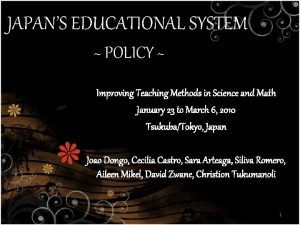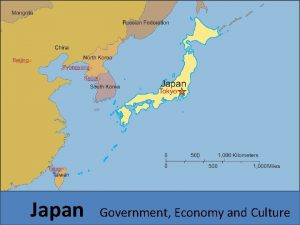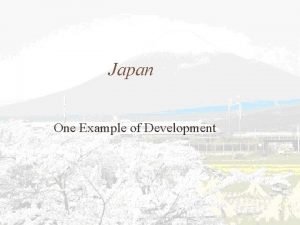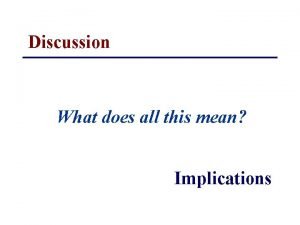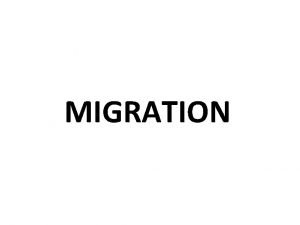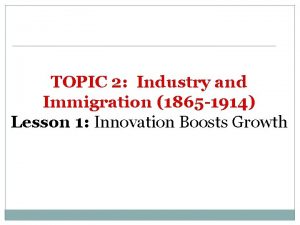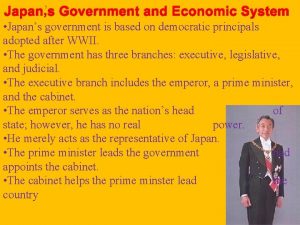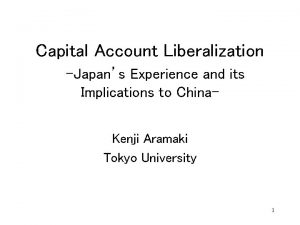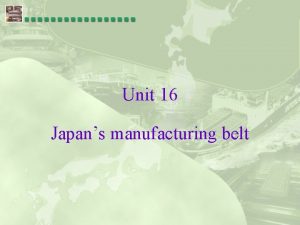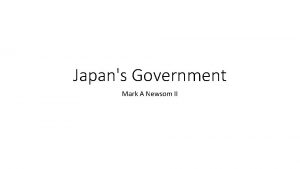Japans Immigration Policy Reform and Its Implications for











- Slides: 11

Japan’s Immigration Policy Reform and Its Implications for the Global Governance in International Migration 一橋大学 Hitotsubashi University 山田 敦 Atsushi YAMADA

The amendment to the Immigration Control and Refugee Recognition Act was passed by Japan’s Diet in December 2018. It will come into effect in April 2019. 1. What’s New? 2. Backgrounds 3. Implications

1. What’s New? New Visa Status: Designated Skilled Labor DSL Category 2 Can stay longer Can come with family Language & Skills Tests DSL Category 1 Can stay up to 5 years Cannot come with family Up to 10 years of stay Language & Skills Tests Existing Visa Status: Technical Intern Trainee 3 year work experience Can stay up to 5 years Source: Nikkei

1. What’s New? “A dramatic change in Japan’s immigration policy” “Finally Japan opened its gate to low-skilled foreign workers. ” “Worsening labor shortage in key industries pushed the nation to rely more on immigrants. ” True or False?

2. Backgrounds Foreign-born workers have been increasing in the past decade. 1. 28 million In 2017 Sourse: Mainichi Shimbun

2. Backgrounds Who are they? (by country of origin, 2016) China (+ Hong Kong) Others G 7/8 + AUS + NZ Peru Foreign workers Brasil S. Korea Nepal Philippines Viet Nam Source: Immigration Bureau of Japan

2. Backgrounds Who are they? (by status, 2016) Unknown Foreign residents based on civil status Workers in professional/ technical fields Workers in designated activities Foreign workers Technical Intern Trainees Part-time workers Source: Immigration Bureau of Japan

3. Implications “A dramatic change in Japan’s immigration policy”? Not really. Even when working permits were not issued, foreign-born low-skilled workers could be found in other visa statuses (e. g. , technical interns, international students, and Japanese Latin Americans). The amendment only switches their visas.

3. Implications “Finally Japan opened its gate to low-skilled foreign workers”? Only partially. With the amendment, perhaps Japan opens its gate to the backyard, but still locks its door to the house. Unless they acquire certain skills, pass the test, and prove that they are no longer “lowskilled, ” foreign workers are supposed to go home sooner or later.

3. Implications “Worsening labor shortage in key industries pushed the nation to rely more on immigrants”? Not necessarily. The government, including Prime Minister Abe himself, repeatedly claimed the amendment was “not an immigration policy. ” It is to increase the workers, not immigrants, at least in the short run.

3. Implications Any implications for the global governance of international migration? Human rights of foreign-born workers were at issue in the policy debate. Other global agendas, however, were almost untouched, e. g. , global refugee crises.
 Alauddin khilji agrarian reform
Alauddin khilji agrarian reform Japans educational system
Japans educational system Japan government type
Japan government type Japans physical geography
Japans physical geography Japans geography
Japans geography What is japans capital city
What is japans capital city Xxxx com japanese
Xxxx com japanese Japans geography
Japans geography Japanese feudal hierarchy
Japanese feudal hierarchy Discussion and implications
Discussion and implications Difference between immigration and emigration
Difference between immigration and emigration Industry and immigration lesson 1 innovation boosts growth
Industry and immigration lesson 1 innovation boosts growth

